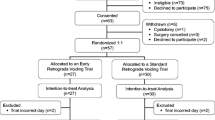Abstract
Introduction and hypothesis
There is a distinct lack of literature on postoperative management after anterior colporrhaphy (AC). Our traditional postoperative protocol consisted of 24 h of indwelling catheterisation followed by 24 h of self-intermittent catheterisation. We hypothesised that a new protocol consisting of only 24 h of indwelling catheterisation might produce better results without additional complications.
Methods
From April 2014 to July 2017, all candidates for AC were randomised to catheter removal 24 or 48 h after surgery. The primary outcome was the postoperative urinary retention (POUR) rate. Secondary outcomes included: asymptomatic bacteriuria (AB), urinary tract infection (UTI) and postoperative pain after 24 h.
Results
A total of 79 patients were recruited. Thirty-seven and 40 patients were randomised to follow the 48-h protocol and the 24-h protocol respectively. There were no significant differences in relation to the POUR rate: 3 patients (8.1%) vs 1 (2.5%) in the 48-h vs the 24-h group respectively (p = 0.346). The UTI rate was 2 (8.1%) vs 0 patients respectively (p = 0.139) and the postoperative AB rate was 3 (9.1%) vs 0 patients (p = 0.106). In the postoperative pain evaluation, the visual analogue scale score was significantly higher in the 48 h group (0.35 vs 0.13, p = 0.02).
Conclusions
According to our results, reducing the catheterisation from 48 to 24 h after AC does not increase the risk of POUR and decreases the rate of UTI, AB and postoperative pain. This new postoperative management protocol of pelvic floor surgery would improve postoperative outcomes and shorten the stay in hospital.


Similar content being viewed by others
References
Maher C, Feiner B, Baessler K, Haya N, Brown J. Surgery for women with anterior compartment prolapse (review) summary of findings for the main comparison. Cochrane Database Syst Rev 2016;11:CD004014.
Hakvoort RA, Burger MP, Emanuel MH, Roovers JP. A nationwide survey to measure practice variation of catheterisation management in patients undergoing vaginal prolapse surgery. Int Urogynecol J. 2009;20(7):813–8.
Haylen BT, Freeman RM, Lee J, Swift SE, Cosson M, Deprest J, et al. An International Urogynecological Association (IUGA)/International Continence Society (ICS) joint terminology and classification of the complications related to native tissue female pelvic floor surgery. Neurourol Urodyn. 2012;31:406–14.
Glavind K, Morup L, Madsen H, Glavind J. A prospective, randomised, controlled trial comparing 3 hour and 24 hour postoperative removal of bladder catheter and vaginal pack following vaginal prolapse surgery. Acta Obstet Gynecol Scand. 2007;86(9):1122–5.
Weemhoff M, Wassen MMLH, Korsten L, Serroyen J, Kampschöer PHNM, Roumen FJME. Postoperative catheterization after anterior colporrhaphy: 2 versus 5 days. A multicentre randomized controlled trial. Int Urogynecol J. 2011;22(4):477–83.
Hakvoort RA, Elberink R, Vollebregt A, Ploeg T, Emanuel MH. How long should urinary bladder catheterisation be continued after vaginal prolapse surgery? A randomised controlled trial comparing short term versus long term catheterisation after vaginal prolapse surgery. BJOG. 2004;111(8):828–30.
Bray R, Cartwright R, Digesu A, Fernando R, Khullar V. A randomised controlled trial comparing immediate versus delayed catheter removal following vaginal prolapse surgery. Eur J Obstet Gynecol Reprod Biol. 2017;210:314–8. https://doi.org/10.1016/j.ejogrb.2017.01.015.
Haylen BT, de Ridder D, Freeman RM, Swift SE, Berghmans B, Lee J, et al. An International Urogynecological Association (IUGA)/International Continence Society (ICS) joint report on the terminology for female pelvic floor dysfunction. Neurourol Urodyn. 2010;29:4–20.
Espuña M, Rebollo PPM. Validation of the Spanish version of the International Consultation on Incontinence Questionnaire-Short Form. A questionnaire for assessing the urinary incontinence. Med Clin. 2004;122:288–92.
Sánchez-Sánchez B, Torres-Lacomba M, Yuste-Sánchez MJ, Navarro-Brazález B, Pacheco-da-Costa S, Gutiérrez-Ortega C, et al. Cultural adaptation and validation of the Pelvic Floor Distress Inventory Short Form (PFDI-20) and Pelvic Floor Impact Questionnaire Short Form (PFIQ-7) Spanish versions. Eur J Obstet Gynecol Reprod Biol. 2013;170(1):281–5.
Mestre M, Lleberia J, Pubill J, Espuña-Pons M. Spanish version of the Pelvic Organ Prolapse/Urinary Incontinence Sexual Questionnaire IUGA-Revised (PISQ-IR): transcultural validation. Int Urogynecol J. 2017;28(12):1865–73.
Haylen BT, Maher CF, Barber MD, Camargo S, Dandolu V, Digesu A, et al. Erratum to: an International Urogynecological Association (IUGA)/International Continence Society (ICS) joint report on the terminology for female pelvic organ prolapse (POP). Int Urogynecol J. 2016;27(4):655–84.
Dicuio M, Pomara G, Menchini Fabris F, Ales V, Dahlstrand CMG. Measurements of urinary bladder volume: comparison of five ultrasound calculation methods in volunteers. Arch Ital Urol Androl. 2005;77(1):60–2.
Kringel U, Reimer T, Tomczak S, Green S, Kundt G, Gerber B. Postoperative infections due to bladder catheters after anterior colporrhaphy: a prospective, randomized three-arm study. Int Urogynecol J. 2010;21(12):1499–504.
Phipps S, Lim YN, McClinton S, Barry C, Rane A, N’Dow JM. Short term urinary catheter policies following urogenital surgery in adults. Cochrane Database Syst Rev. 2006;2:CD004374.
Saaby ML, Lose G. Repeatability of post-void residual urine ≥ 100 ml in urogynaecologic patients. Int Urogynecol J. 2012;23(2):207–9.
Haylen BT, Lee J. The accuracy of post-void residual measurement in women. Int Urogynecol J. 2008;19(5):603–6.
Wang R, Won S, Haviland MJ, Von Bargen E, Hacker MR, Li J, et al. Voiding trial outcome following pelvic floor repair without incontinence procedures. Int Urogynecol J. 2016;27(8):1215–20.
Hakvoort RA, Dijkgraaf MG, Burger MP, Emanuel MH, Roovers JP. Predicting short-term urinary retention after vaginal prolapse surgery. Neurourol Urodyn. 2009;28:225–8.
Alonzo-Sosa JE, Flores Contreras JT, Paredes-Canul M. Method for transurethral catheterization for 1–3 days for pelvic floor relaxation in the postoperative period. Ginecol Obstet Mex. 1997;65:455–7.
Author information
Authors and Affiliations
Corresponding author
Ethics declarations
Conflicts of interest
None.
Rights and permissions
About this article
Cite this article
Fernandez-Gonzalez, S., Martinez Franco, E., Martínez-Cumplido, R. et al. Reducing postoperative catheterisation after anterior colporrhaphy from 48 to 24 h: a randomised controlled trial. Int Urogynecol J 30, 1897–1902 (2019). https://doi.org/10.1007/s00192-018-3818-9
Received:
Accepted:
Published:
Issue Date:
DOI: https://doi.org/10.1007/s00192-018-3818-9




